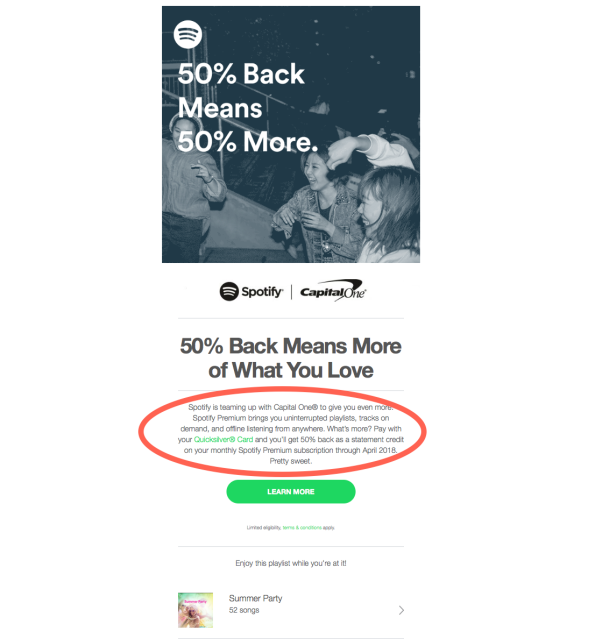Spotify’s Latest Premium: 50% Back Means 50% Less
Spotify's latest "50% back means 50% more" ploy to use its music service to allow Capital One to sell subscribers indebtedness is raising some eyebrows. In fact, Attorney Chris Castle says the deal would likely be illegal were it made with any artist one-on-one.
_________________________
Guest post by Chris Castle of Music •Technology • Policy

Spotify is using its music service to help Capital One sell indebtedness. And by the look of the campaign, Spotify is helping Capital One try to make debt groovy for millennials. That would be the millennials who probably owe tens if not hundreds of thousands of dollars for the college diploma they admire when they get back to their micro apartment from a long day of baristaing.
Yet if Capital One tried to make the same deal with any single artist for this kind of premium tie-in, the artists could likely block it. Why? Most record deals give the artist a “marketing restriction” that looks something like this:
Label will not use Masters made under this agreement in premium Records to promote the sale of any product or service other than Records. The restriction set forth in this subparagraph shall apply during and after the Term.
This prohibition is usually absolute and is generally an easy give by the label in a new artist negotiation. That’s why you don’t see too many premiums out there in the market place.
But–Spotify breaks the loophole mold again. Not only do they associate music with a credit card (something that some artists will object to, particularly progressives who may not look too kindly on banks–see Consumer Financial Protection Bureau) but Spotify also takes the next step–using music as a loss leader to promote credit cards.
Capital One gets to have their music industry tie in by having all the music for a premium. And Spotify probably got a branding fee that they do not share will the artists in return.
On top of it all–Spotify diminishes the value of music by using the 50% discount–that’s right 50%–as a loss leader for both Spotify’s subscription service (aka the valuable part of the Spotify service) and for Capital One to sell more indebtedness to fans.
Even if Capital One is in fact paying full rate and just discounting to its card holders, which I seriously doubt, the campaign itself devalues and disrespects music by treating us as a commodity that can be bartered for a fee.
That’s why the marketing restriction on premiums in the first place. So Spotify is doing indirectly that which they probably never could do directly. So what’s in their wallet?
Guys, a little journalistic integrity…. Making claims like “Spotify probably got a branding fee that they do not share with the artists in return” based purely on conjecture is completely messed up. To start, it’s actually more likely that they didn’t get a fee from Capital One, but rather that Capital One’s end of the bargain was paying 50% of the subscriber fee for whatever term the deal applies, and paying for a percentage of the advertising revenues to promote the campaign. If they get 50k subscribers off this campaign, that’s $250k per month they have to pay Spotify to cover the subscription costs, so I doubt they’re paying them a fee on top of that. And then for every $10 they take, $6 goes directly to the labels (which THEY don’t payout to their artists, in addition to the massive advances they take from Spotify in order to have the rights to their catalogs). From the remaining $4/month/user, they then divvy up 70% of that to rights holders.
All this partnership is doing for Spotify, is bringing in more subscribers, which is what we all want. To suggest that artists are suffering from this promotion is absurd, because it’s the labels that actually own the music, and if you think the labels are going to let themselves get screwed out of even a dollar just to let Spotify run a promotional campaign, you don’t know anything about record labels. They’re getting their full rate on every subscriber, and if Capital One is willing to cover some of that cost in order to be associated with music, LET THEM.
Moreover, are you serious with this quote: “the campaign devalues itself and disrespects music by treating us as a commodity that can be bartered for a fee”?!? Please get off your high horse and realize that music is a commodity, and it’s value unfortunately isn’t worth sh*t right now.The best thing that could happen for music is to get buried as a loss leader promotional bonus for a service like Amazon Prime or Netflix, that people ARE willing to pay for. I just don’t understand… do you want artists to get paid, or do you want to make people artists get paid ‘by people’ as a showing of respect for their craft? Ask any artist if they’d rather get paid $20k a month, or $10k a month – but none of it was helped by banks – and see what they have to say.
Bottom line, hating on this deal is childish, misguided, and shortsighted. The record labels are the ones screwing over the artists—don’t get mad at the company trying desperately to get people to pay for music again just because you think it’s cool to hate on banks. And, if you want to be respected as a music news site, don’t make claims based purely on conjecture as you try to roast one of the few companies that’s trying to save the recorded music business. I mean, do you really want to be the FOX News of music?